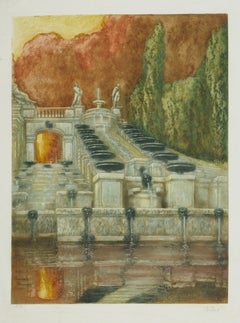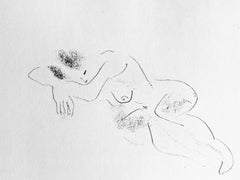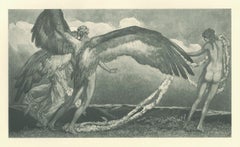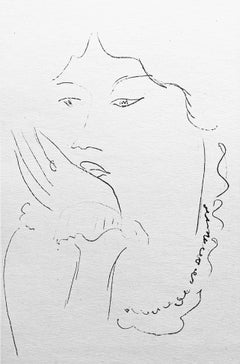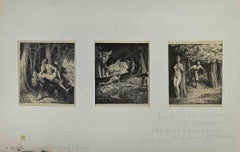Early 20th Century Landscape Prints
to
495
920
188
68
29
23
Overall Width
to
Overall Height
to
495
192
78
36
33
8
5
2
1
169
42
26
18
16
1,011
2,153
9,959
4,023
116
114
698
512
594
1,140
1,461
1,650
1,316
628
658
739
488
1
730
560
277
227
156
152
125
123
89
82
81
67
64
61
61
52
52
50
43
43
472
359
294
167
151
130
151
917
262
Period: Early 20th Century
La Grande Cascade de Saint Cloud
Located in Fairlawn, OH
La Grande Cascade de Saint Cloud
Color aquatint on watermarked Arches J Perrigot paper, 1905
Signed by the artist in pencil lower right. (see photo)
Edition: 100. Numbered "39" in ...
Category
French School Early 20th Century Landscape Prints
Materials
Aquatint
Henri Matisse, Crayon, from Drawings by Henri Matisse, 1925 (after)
Located in Southampton, NY
This exquisite lithograph after Henri Matisse (1869–1954), titled Crayon (Crayon), from the album Dessins de Henri-Matisse (Drawings by Henri Matisse), originates from the 1925 editi...
Category
Modern Early 20th Century Landscape Prints
Materials
Lithograph
$956 Sale Price
20% Off
Fall Der Engel - Vintage Héliogravure by Franz von Bayros - 1921 ca.
Located in Roma, IT
Fall Der Engel is a black and white héliogravure on cream-colored cardboard realized by Choisy Le Conin, as is remembered Franz Von Bayros (Agram, 1866 – Vienna, 1924).
From Mappe, ...
Category
Symbolist Early 20th Century Landscape Prints
Materials
Engraving
Henri Matisse, Crayon, from Drawings by Henri Matisse, 1925 (after)
Located in Southampton, NY
This exquisite lithograph after Henri Matisse (1869–1954), titled Crayon (Crayon), from the album Dessins de Henri-Matisse (Drawings by Henri Matisse), originates from the 1925 edition published by Editions des Quatre Chemins, Paris, rendered by Daniel Jacomet, Paris, and printed by Atelier Daniel Jacomet et Cie, Paris, December 15, 1925. The work exemplifies Matisses mastery of pure line and the expressive economy of form that defined his graphic art of the 1920s, transforming simplicity into lyrical harmony.
Executed as a lithograph on velin Lafuma Navarre paper, this work measures 10 x 8 inches (25.4 x 20.32 cm). Unsigned and unnumbered, as issued. The edition exemplifies the refined craftsmanship of the Daniel Jacomet et Cie workshops, Paris.
Artwork Details:
Artist: After Henri Matisse (1869–1954)
Title: Crayon (Crayon), from the album Dessins de Henri-Matisse (Drawings by Henri Matisse)
Medium: Lithograph on velin Lafuma Navarre paper
Dimensions: 10 x 8 inches (25.4 x 20.32 cm)
Inscription: Unsigned and unnumbered, as issued
Date: 1925
Publisher: Editions des Quatre Chemins, Paris
Printer: Atelier Daniel Jacomet et Cie, Paris
Catalogue Raisonne Reference: Duthuit, Claude. Henri Matisse: Catalogue raisonne des ouvrages illustres. Editions Claude Duthuit, Paris, 1988, illustration 3.
Condition: Well preserved, consistent with age and medium
Provenance: From the album Dessins de Henri-Matisse (Drawings by Henri Matisse), published by Editions des Quatre Chemins, Paris; rendered by Daniel Jacomet, Paris; printed by Atelier Daniel Jacomet et Cie, Paris, December 15, 1925
Notes:
Excerpted from the album (translated from French), This album was printed in C examples on velin d'Arches with an original example by Henri-Matisse, numbered from I to C, and M examples on velin Lafuma. Printing was completed on December Fifteenth, One Thousand, Nine Hundred and Twenty-Five by F. Dutal et Cie, in Paris; the boards having been executed by the Daniel Jacomet et Cie workshops in Paris.
About the Publication:
Dessins de Henri-Matisse (Drawings by Henri Matisse), published by Editions des Quatre Chemins, Paris, in 1925, is a landmark early graphic portfolio that captures the artist’s mastery of contour and proportion through a series of delicately rendered lithographs. Realized under the direction of the Daniel Jacomet et Cie workshops—renowned for their exceptional skill in fine art printmaking—the album showcases Matisse’s fascination with the purity of line and the human form. Issued in a limited printing of examples on both velin d’Arches and velin Lafuma papers, it reflects the refined aesthetics and technical excellence that characterized the interwar Parisian print ateliers. The publication represents a pivotal stage in Matisse’s evolution as a draughtsman, bridging the intimate immediacy of his drawings with the permanence of fine print.
About the Artist:
Henri Matisse (1869–1954) was a French painter, sculptor, draughtsman, and printmaker whose revolutionary vision redefined modern art through his daring use of color, line, and form. Celebrated as one of the greatest artists of the 20th century, Matisse led the Fauvist movement and devoted his life to the pursuit of balance, beauty, and emotional expression in visual art. His early works burst with vibrant hues and liberated brushwork, while his later “cut-out” compositions achieved a poetic simplicity that transformed the relationship between color and space. Deeply influenced by the work of Paul Cezanne, Vincent van Gogh, and Georges Seurat, as well as by the rhythmic patterns of Islamic art, Byzantine mosaics, and Japanese prints, Matisse forged a new visual language that celebrated joy, movement, and serenity. He was part of an extraordinary generation of artists who shaped the evolution of modernism, maintaining lifelong dialogue and friendly rivalry with contemporaries such as Pablo Picasso, Georges Braque, Marc Chagall, Andre Derain, Albert Marquet, and Raoul Dufy—peers who, like him, sought to expand the expressive potential of color and composition. Matisses influence extended across generations, inspiring modern and contemporary masters including Alexander Calder, Alberto Giacometti, Salvador Dali, Joan Miro, Wassily Kandinsky, Marcel Duchamp, and Man Ray, each of whom drew upon his fearless experimentation and refined visual harmony. His paintings, sculptures, and works on paper are held in the most prestigious museums in the world, including the Museum of Modern Art, the Centre Pompidou, the Tate, and the Hermitage Museum, where his art continues to symbolize the essence of creativity and human emotion. The highest price ever paid for a Henri Matisse artwork is approximately 80.8 million USD, achieved in 2018 at Christies New York for Odalisque couchee aux magnolias (1923).
Henri Matisse Crayon...
Category
Modern Early 20th Century Landscape Prints
Materials
Lithograph
$956 Sale Price
20% Off
Echo et Narcisse - Lithograph by Auguste Roubille - 1911
Located in Roma, IT
Echo et Narcisse is an artwok realized in 1911, by the French Artist Auguste Roubille (1872-1955).
Three Lithographs print on paper, cm 20x15 cad. Signed in plate. The artwork is p...
Category
Modern Early 20th Century Landscape Prints
Materials
Lithograph
Brittany Landscape with Figure
Located in Fairlawn, OH
Brittany Landscape with Figure
Etching & color aquatint, c. 1920
Signed lower right (see photo)
Numbered lower left: "No. 21" (see photo)
An early color etching by the artist, based ...
Category
American Impressionist Early 20th Century Landscape Prints
Materials
Aquatint
William Tatton Winter (1855-1928) - Framed Etching, The Close Gate Salisbury
By William Tatton Winter
Located in Corsham, GB
A fine etching in colours by the well listed artist William Tatton Winter (1855-1928). Signed in pencil below plate lines. Inscribed in plate to the lower left. Smartly mounted in a ...
Category
Early 20th Century Landscape Prints
Materials
Etching
Normandy : La Frette sur Seine - Lithograph, Ltd /200
Located in Paris, IDF
Albert MARQUET
Normandy : La Frette sur Seine
Original lithograph
Signed with the artist stamp
Numbered / 200
On Arches vellum 45 x 57 cm (c. 18 x 23 in)
Excellent condition
Category
Post-Impressionist Early 20th Century Landscape Prints
Materials
Lithograph
“Longs Peak & Mount Meeker” Color Aquatint Etching by George Elbert Burr
Located in Denver, CO
This original early 20th-century color aquatint etching by celebrated American printmaker George Elbert Burr (1859–1939) captures the majestic beauty of Longs Peak and Mount Meeker a...
Category
American Impressionist Early 20th Century Landscape Prints
Materials
Aquatint
The Old Surrey and Burstow Hunt hunting print by Lionel Edwards
Located in London, GB
To see our other hunting pictures, scroll down to "More from this Seller" and below it click on "See all from this Seller" and then search.
Lionel Ed...
Category
Early 20th Century Landscape Prints
Materials
Lithograph
Le Marché aux Puces
Located in Middletown, NY
Published in Paris by Chalcographie Louvre around 1910. Drypoint etching on buff wove paper, 7 x 11 inches (175 x 278 mm) full margins. With the "Musée Louvre Chalcographie" blind st...
Category
French School Early 20th Century Landscape Prints
Materials
Handmade Paper, Drypoint, Etching
Italian State Railways - Lithograph by A. Terzi - Early 20th Century
Located in Roma, IT
Italian State Railways is an original artwork realized in the early century by Aleardo Terzi.
Mixed colored lithograph.
A vintage affiche depicting Ita...
Category
Art Nouveau Early 20th Century Landscape Prints
Materials
Lithograph
Nymphe et Faunes - Etching by K.-X. Roussel - 1900 ca.
Located in Roma, IT
Image dimensions: 11,7 x 15,3 cm.
Hand signed in pencil. Note lower left "3em état". Artist's proof, III state.
Original etching.
Ref: Catalogue Salomon n. 116.
Category
Modern Early 20th Century Landscape Prints
Materials
Etching
Landscape - Etching on Paper by Francesco Vitalini - 1904
Located in Roma, IT
Landscape is an original etching artwork realized in the 1904 ca. by Italian artist Francesco Vitalini.
Hand-signed on the lower right in pencil.
The State of preservation is very ...
Category
Early 20th Century Landscape Prints
Materials
Etching
$418 Sale Price
30% Off
Drei Hauser Grun-violette Stufung, Framed Cubist Pochoir by Paul Klee
Located in Long Island City, NY
Artist: Paul Klee, After, Swiss (1879 - 1940)
Title: Drei Hauser Grun-violette Stufung (Troi Maisons Gradation vert-violet)
Year: 1964, after 1922 Drawing
Medium: Pochoir on Rice Pap...
Category
Modern Early 20th Century Landscape Prints
Materials
Stencil
"Home of Mary Washington" Antique Fredericksburg. Virginia Etching
Located in Soquel, CA
"Home of Mary Washington" Antique Fredericksburg. Virginia Etching
Detailed architectural etching by Ernest David Roth (American b. 1879 d. 1964.) The etching depicts the house of M...
Category
Realist Early 20th Century Landscape Prints
Materials
Paper, Ink, Etching
Norwich – The Cathedral Route Original Vintage British Travel Poster
Located in Zurich, CH
Original Vintage Travel Poster by Frank Newbould, commissioned by LNER (The London & North Eastern Railway of England & Scotland) to promote its connection to Norwich; beautifully pr...
Category
English School Early 20th Century Landscape Prints
Materials
Paper
Reguliersracht during winter, Amsterdam
Located in Middletown, NY
Etching with drypoint on cream wove paper with a deckle edge, 6 7/8 x 4 7/8 inches (200 x 125 mm); sheet 15 x 11 inches (380 x 280 mm), full margins. In excellent condition with mino...
Category
Dutch School Early 20th Century Landscape Prints
Materials
Drypoint, Etching
Authentic Japanese Woodblock Print-Birds and Flowers-Edo-Fan Re-carved 1920s
By Utagawa Sadahide
Located in London, GB
This rare Original 1920s authentic print is a Taisho Period Woodblock print published from the Japan 1920's The Nippon Mokuhan Gasui, Masterpieces Series.;
it is authentically hand ...
Category
Early 20th Century Landscape Prints
Materials
Ink, Handmade Paper
Leonard R. Squirrel (1893–1979) - Early 20th Century Mezzotint, Notre Dame
Located in Corsham, GB
This charming mezzotint depicts the façade of Notre Dame in Paris. Signed in graphite below the plate lines. On paper.
Category
Early 20th Century Landscape Prints
Materials
Mezzotint
Original 1914 Ski Poster Zug Berg-u-Strassenbahn, Austria: Walther Koch - Skiing
By Walter Koch
Located in London, GB
Walther Koch (1875-1915)
Zug Berg und Strassenbahn
Original lithographic poster (1914)
40x30"
Printed in Zurich by Anstalt Gebr Fretz
Category
Modern Early 20th Century Landscape Prints
Materials
Lithograph
The Belvoir Hunt hunting print by Lionel Edwards
Located in London, GB
To see our other hunting pictures, scroll down to "More from this Seller" and below it click on "See all from this Seller" and then search.
Lionel Ed...
Category
Early 20th Century Landscape Prints
Materials
Lithograph
Grim Orvieto
Located in Middletown, NY
Etching on watermarked FJ Head cream laid paper with a deckle edge, 11 1/8 x 8 3/4 inches (283 x 223 mm); sheet 14 3/4 x 11 1/2 inches (374 x 292 mm), full margins. Signed and dated ...
Category
American Modern Early 20th Century Landscape Prints
Materials
Handmade Paper, Etching, Laid Paper
Original U. S. Marines, Soldiers of the Sea vintage WW1 poster linen backed
Located in Spokane, WA
Original U.S. Marines "Soldiers of the Sea" vintage poster by J.C. Leyendecker (c. 1917); linen-backed in A-, B+ condition, ready to frame.
The poster h...
Category
Art Deco Early 20th Century Landscape Prints
Materials
Offset
The Berkeley Hunt hunting print by Lionel Edwards
Located in London, GB
To see our other hunting pictures, scroll down to "More from this Seller" and below it click on "See all from this Seller" and then search.
Lionel Edwards (1878 - 1966)
The Berkeley Hunt...
Category
Early 20th Century Landscape Prints
Materials
Lithograph
Wonderground Map of London by MacDonald 'Max' Gill c. 1924 original poster
Located in London, GB
To see our other original vintage posters and views of London (including original paintings), scroll down to "More from this Seller" and below it click on "See all from this Seller" ...
Category
Modern Early 20th Century Landscape Prints
Materials
Lithograph
Yoshida Hiroshi -- The Golden Pavilion 金阁
By Yoshida Hiroshi
Located in BRUCE, ACT
Title "The Golden Pavilion" 金阁
Date 1933; (posthumous edition, likely 1950's/60's).
Publisher Yoshida Family Studio
Image Size 9 5/8 x 14 3/4
Impression Very Fine. Sk...
Category
Early 20th Century Landscape Prints
Materials
Woodcut
$704 Sale Price
20% Off
La Chasse au Tigre, Surrealist Aquatint Etching by Jacques Villon
Located in Long Island City, NY
Artist: Jacques Villon, After Henri Rousseau, French (1844 - 1910), French (1875 - 1963)
Title: La Chasse au Tigre
Year: 1924
Medium: Etching with Aquatint, signed and dated in th...
Category
Impressionist Early 20th Century Landscape Prints
Materials
Etching, Aquatint
Coin de Rue Dans Soho
Located in New York, NY
Jean-Emile Laboureur (1877-1947), Coin de Rue Dans Soho, woodcut, 1909, signed in pencil lower left and numbered (15/15) [also initials in the plate]. Reference: Sylvain Laboureur 64...
Category
Modern Early 20th Century Landscape Prints
Materials
Woodcut
"Edward King Polo Scene"
Located in Bristol, CT
Classic polo scene drawn on stone featuring six ponies on the field drawn on stone & signed by Edward King (LL)
Print Sz: 10 3/4"H x 18 1/2"W
Frame Sz: 18"H x 25 3/8"W
Category
Early 20th Century Landscape Prints
Materials
Paper, Lithograph
Untitled (Moulin Rouge and other Paris landmarks)
Located in Fairlawn, OH
Untitled (Moulin Rouge and other Paris landmarks)
Lithograph, 1926
Rare signed in pencil proof on chine paper (see photo)
Lithograph from Joseph Delteil's "Allo, Paris," published by...
Category
Modern Early 20th Century Landscape Prints
Materials
Lithograph
Don Quixote
Located in Middletown, NY
Etching on a large sheet of light cream wove paper, Baron Dominique Vivant Denon (after Jean-Honoré Fragonard); Paris: c 1900; 4 3/4 x 3 1/2 inc...
Category
French School Early 20th Century Landscape Prints
Materials
Handmade Paper, Etching
Fernand Leger, Mural Painting, from Cahiers d'Art, 1928 (after)
Located in Southampton, NY
This exquisite lithograph and pochoir after Fernand Leger (1881–1955), titled Peinture murale (Mural Painting), from the album Fernand Leger (Fernand Leger), originates from the 1928...
Category
Modern Early 20th Century Landscape Prints
Materials
Lithograph
$2,396 Sale Price
20% Off
"Harvest Home - Henry Alford Poem, " Color Lithograph Poster of Pumpkins & Hay
Located in Milwaukee, WI
"Harvest Home" is an original color lithograph poster by an unknown artist. It features a scene of a field with a few pumpkins and wheat. Below the image is an excerpt from a Henry A...
Category
Other Art Style Early 20th Century Landscape Prints
Materials
Lithograph
On the Kedgwick
By Frank Benson
Located in New York, NY
Frank Benson created the etching "On the Kedgwick" in 1923, in an edition of 150. This impression is the second state of four. There are five known impressions of the second state. It is signed in pencil and inscribed "B-1" and "1 or 5" at the lower left paper edge (pencil). The image size 7 13/16 x 11 7/8" (19.9 x 30.2 cm) and sheet size 15 3/8 x 11 1/2" )29.3 x 39 cm). It is listed in the Frank W. Benson catalogue raisonne by Paff #222.
FRANK W. BENSON (1862-1951)
Frank Weston Benson, well known for his American impressionist paintings, also produced an incredible body of prints - etchings, drypoints, and a few lithographs. Born and raised on the North Shore of Massachusetts, Benson, a natural outdoorsman, grew up sailing, fishing, and hunting. From a young age, he was fascinated with drawing and birding – this keen interest continued throughout his life.
His first art instruction was with Otto Grundman at the Museum of Fine Arts in Boston, and then in 1883 in Paris at the Academie Julian where he studied the rigorous ‘ecole des beaux arts’ approach to drawing and painting for two years.
During the early 1880’s Seymour Haden visited Boston giving a series of lectures on etching. This introduction to the European etching...
Category
Impressionist Early 20th Century Landscape Prints
Materials
Etching
Henri Matisse, Plume, from Drawings by Henri Matisse, 1925 (after)
Located in Southampton, NY
This exquisite lithograph after Henri Matisse (1869–1954), titled Plume (Feather), from the album Dessins de Henri-Matisse (Drawings by Henri Matisse), originates from the 1925 editi...
Category
Modern Early 20th Century Landscape Prints
Materials
Lithograph
$956 Sale Price
20% Off
General/The North Downs
Located in New York, NY
D. Legg.
General/The North Downs, Ca 1921 Color lithograph.
Designed posters for London Transport 1929.
No Biography available.: London Transport Museum Collectiom
Category
Art Deco Early 20th Century Landscape Prints
Materials
Lithograph
VALLEY OF THE TIBER
Located in Portland, ME
Howarth, Albany. VALLEY OF THE TIBER. Etching, not dated. Edition size not known.
Signed in pencil lower right. 13 3/4 x 10 1/2 inches (plate), 19 5/8 x 14 3/4 inches (sheet). In ex...
Category
Early 20th Century Landscape Prints
Materials
Etching
"Under the Street Lamp" Imp. Etching
By Martin Lewis
Located in Houston, TX
Copperplate etching by Martin Lewis titled "Under the Street Lamp." Edition of 100. Printed on laid paper with watermark and 83 recorded impressions. McCarron catalogue raisonne #70. Signed in pencil with "imp" next to the signature. In the bottom right corner is a penciled 75 and in the top right corner is a 50. The etching is framed and was taken out of the frame for condition report and photographs. The gallery label is on the back of the matte inside the frame.
Dimensions without Frame: H 15 in x W 9.5 in.
Artist Biography: Martin Lewis (1881-1962) was born in Castlemaine, Victoria, Australia on 7 June 1881. He was the second of eight children and had a passion for drawing. At the age of 15, he left home and traveled in New South Wales, Australia, and in New Zealand, working as a pothole digger and a merchant seaman. He returned to Sydney and settled into a Bohemian community outside Sydney. Two of his drawings were published in the radical Sydney newspaper, The Bulletin. He studied with Julian Ashton at the Art Society's School in Sydney. Ashton, an English-born Australian artist and teacher, known for his support of the Heidelberg School and for his influential art school in Sydney. In 1900, Lewis left Australia for the United States. His first job was in San Francisco, painting stage decorations...
Category
Naturalistic Early 20th Century Landscape Prints
Materials
Etching, Laid Paper
Stanwick
Located in Middletown, NY
A superb impression of a scarce proof on rare paper.
Etching on blue laid watermarked "Hand Made" paper, 7 3/8 x 3/14 inches (188 x 83 mm); sheet 11 1/2 x 8 1/4 inches (292 x 209 mm...
Category
American Modern Early 20th Century Landscape Prints
Materials
Handmade Paper, Etching, Laid Paper
H.O. Miethke Das Werk folio "Fruit Trees" collotype print
Located in Palm Beach, FL
DAS WERK GUSTAV KLIMTS, a portfolio of 50 prints, ten of which are multicolor collotypes on chine colle paper laid down on hand-made heavy cream wove paper with deckled edges; under ...
Category
Vienna Secession Early 20th Century Landscape Prints
Materials
Paper
Composition, Vers un monde volage, Marcel Gromaire
Located in Southampton, NY
Etching on vélin d'Arches paper. Unsigned and unnumbered, as issued. Good condition. Published by Éditions Marcel Seheur, Paris; printed by Atelier d'art Paul Haasen, Paris, Septembe...
Category
Modern Early 20th Century Landscape Prints
Materials
Etching
$1,436 Sale Price
20% Off
Le Corbusier's Villa Savoye 1929 – Original Swiss Vintage Exhibition Poster
Located in Zurich, CH
Original Vintage Poster, issued 1987 by the ETH in Zurich on the occasion of its exhibition on Le Corbusier's famous – and revolutionary – Villa Savoye, c...
Category
Modern Early 20th Century Landscape Prints
Materials
Paper
Three Herons - At the flaming lake -
Located in Berlin, DE
Rudolf Hayder (active in the 1st half of the 20th century), Heron. Color woodcut on thin Japanese paper, 24 x 29 cm (image), 29 x 36 cm (sheet size), signed by hand at lower right "R. Hayder" and titled by hand as "Reiher". Lower left inscribed by hand "Orig.[inal] woodcut, hand print".
- A little bit stained in the margins and very occasionally in the image, minimal hole above the signature, traces of creasing. At the back side's margins with remnants of an old mounting.
About the artwork
In the context of French Japonism, the color woodblock print, which was widespread in the Asian region, was rediscovered for Western art. The artists of the time, such as Édouard Manet, Claude Monet, Edgar Degas, Paul Gauguin and Vincent van Gogh, were inspired not only by the cultural influence, but also by the two-dimensionality of the pictorial spaces. Thus, color woodcuts became an important moment in the development of the modern pictorial concept founded by Impressionism.
In Rudolf Hayder's "Herons", too, the two-dimensionality of the pictorial space is decisive for the pictorial effect. The herons, surrounded by reeds, are framed by the yellow background of the lake, followed by the dark blue-greenish stripe of the opposite shore and, above it, the sky in a lighter blue-green. Formally, it is a sequence of planes, but the two-dimensionality of the motif creates a spatial effect. This spatiality in the surface creates an intense pictorial effect. Hayder intensifies this effect with the blazing lake. In terms of color, the water becomes a sunset. The yellow turns reddish brown toward the shore, then fades to brownish red, while the shore is a watery turquoise...
Category
Realist Early 20th Century Landscape Prints
Materials
Color
Le chemin de l'eglise
Located in Fairlawn, OH
Signed and numbered in pencil; Signed in the plate
Edition: 75
Provenance:
Frederick Keppel & Co. Inc. No. L 8621 (label)
References And Exhibitions:
Published by Edmund Sagot, ...
Category
Early 20th Century Landscape Prints
Materials
Etching
"Vue prise de Saardam" (Zaandam) original etching
Located in Henderson, NV
Medium: original color etching. Catalogue reference: Kraemer 23. Executed in 1906, this impression on cream laid paper is from the rare 1906 first edition of "Histoire des Peintres I...
Category
Early 20th Century Landscape Prints
Materials
Etching
Guardians of the Spire (Amiens Cathedral Number 2)
Located in Storrs, CT
Guardians of the Spire (Amiens Cathedral Number 2). 1921. Etching. Fletcher 102. 6 3/4 x 9 7/8 (sheet 8 7/8 x 13 3/4). Gargoyle Series #4. Edition 75. Illustrated: Dorothy Noyes Arms...
Category
American Modern Early 20th Century Landscape Prints
Materials
Drypoint, Etching
$2,000 Sale Price
20% Off
LUDGATE HILL
Located in Santa Monica, CA
JOSEPH PENNELL (1857- 1926)
LUDGATE HILL, 1906 (Wuerth 418)
Etching 10 ½ x 8 ¼ inches on full sheet 11 3/8 x 9 7/8 inches. with irregular deckle edges. Good condition. Wuerth’s assu...
Category
Impressionist Early 20th Century Landscape Prints
Materials
Etching
The Wave - Rare early 20th Century British print by George Sheringham
Located in London, GB
GEORGE SHERINGHAM
(1884-1937)
The Wave
Signed and numbered 2
Stencil print with 9 plates, designed and cut by the artist, fan shaped
23 by 42 cm., 9 by 16 ½ in.
(frame size 37.5 by 22 cm., 14 ¾ by 8 ¾ in.)
Sheringham was born in London and studied at the Slade under Henry Tonks and later in Venice, Brussels, Berlin and Paris where he held his first one-man exhibition in 1905. On his return to London he initially supported himself with poster designs and teaching. His first exhibition of fan designs was held at the Ryder Gallery in 1909 followed by another in the following year. With enthusiastic reviews in Studio he had launched his career as a decorative designer, theatrical designer and illustrator. He illustrated books by Max Beerbohm and Cyrus MacMillan. In 1921 he collaborated with his brother Hugh on a book about fishing, The Book of the Fly Rod. He wrote Drawing in Pen and Pencil (1922), with James Laver, Design in the Theatre (1927) and with Rupert Mason and R Boyd Morrison he edited Robes of Thespis, Costume Designs by Modern Artists (1928). As a decorator, Sheringham designed the music room at 40 Devonshire House...
Category
Art Deco Early 20th Century Landscape Prints
Materials
Screen
Otto Kuhler Signed Original Etching “Mississippi Evening”
By Otto Kuhler
Located in Phoenix, AZ
Otto Kuhler (1894-1976) original etching, 1923. Title: “Mississippi Evening”
Signed in pencil lower right. Title in pencil lower center. Dated lower left, 1923.
Image measures 7 7/8...
Category
Early 20th Century Landscape Prints
Materials
Etching
Trees on the Shore of Grunewaldsee, from: Berlin Impressions - German Berlin
By Lesser Ury
Located in London, GB
This original etching and drypoint is hand signed in pencil by the artist "L. Ury" at the lower left margin.
It is numbered 20 from the standard edition of 100. There was also an edi...
Category
Impressionist Early 20th Century Landscape Prints
Materials
Drypoint, Etching
RAINY SUNDAY AT SAN MARCO
Located in Portland, ME
Hornby, Lester. RAINY SUNDAY AT SAN MARCO. Falk, 308, Kennedy 32. Etching, 1908. Edition of 60. Titled and signed in the plate and signed in pencil in the margin, lower right. 5 7/8 ...
Category
Early 20th Century Landscape Prints
Materials
Etching
Henri Matisse, Fusain, from Drawings by Henri Matisse, 1925 (after)
Located in Southampton, NY
This exquisite lithograph after Henri Matisse (1869–1954), titled Fusain (Charcoal), from the album Dessins de Henri-Matisse (Drawings by Henri Matisse), originates from the 1925 edi...
Category
Modern Early 20th Century Landscape Prints
Materials
Lithograph
$956 Sale Price
20% Off
The Bridge of Sighs, Venice, by Walter Henry Sweet & John Shapland
Located in Middletown, NY
Etching with engraving on cream laid paper with a partial watermark, 12 x 8 1/4 (305 x 210 mm); sheet 16 3/4 x 11 inches (425 x 280 mm), full margins. Signed by both Sweet and Shapla...
Category
American Modern Early 20th Century Landscape Prints
Materials
Handmade Paper, Laid Paper, Etching, Engraving
Medieval Pageantry
Located in Middletown, NY
A complicated collaboration between two perfectionists.
by John Taylor Arms & Kerr Eby
Etching on cream laid paper with a deckle edge, 12 5/8 x 8 11/16 (322 x 222 mm); sheet 18 x 11...
Category
American Modern Early 20th Century Landscape Prints
Materials
Handmade Paper, Etching
'Chicago Harbor' — Urban Realism
By Anton Schutz
Located in Myrtle Beach, SC
Anton Schutz, 'Chicago Harbor', etching, edition 100, c. 1927. Signed and numbered '87/100' in pencil. Annotated '580 Chicago Harbor', in another hand, in the bottom left margin. A f...
Category
American Realist Early 20th Century Landscape Prints
Materials
Etching
Original "If Only Women Knew" -Om Kvinnan Bara Visste silent movie poster, 1921
Located in Spokane, WA
Original 1921 Swedish Silent Movie Poster – "Om kvinnan bara visste" ("If Only Women Knew"). Linen-backed, ready to frame. Grade A- condition. These posters were hand printed one co...
Category
Art Deco Early 20th Century Landscape Prints
Materials
Lithograph
Wilby Church Northamptonshire
Located in Middletown, NY
Etching on cream laid antique J Whatman paper with a watermark, 4 1/2 x 2 3/8 inches (109 x 61 mm); sheet 8 1/2 x 6 1/8 inches (216 x 153 mm), full margins. A proof impression from t...
Category
American Modern Early 20th Century Landscape Prints
Materials
Handmade Paper, Laid Paper, Etching
Art Nouveau : Sailboats with First Quarter Moon - Original lithograph
Located in Paris, IDF
Henri RIVIERE (1884-1951)
Brittany: The Magic of the Hours, First Quarter, 1901
Original lithograph (Eugène Verneau Printing)
Signed on the plate
On paper, 68 x 31 cm (c. 27 x 12 in...
Category
Art Deco Early 20th Century Landscape Prints
Materials
Lithograph
Beach and Willows
By Frederick Garrison Hall
Located in New York, NY
Frederick Garrison Hall (1879-1946), Beach and Willows, etching, c. 1920, signed in pencil by the artist (?) and annotated "by HPH". Reference: Elton Waylon Hall: Frederick Garrison ...
Category
American Realist Early 20th Century Landscape Prints
Materials
Etching
